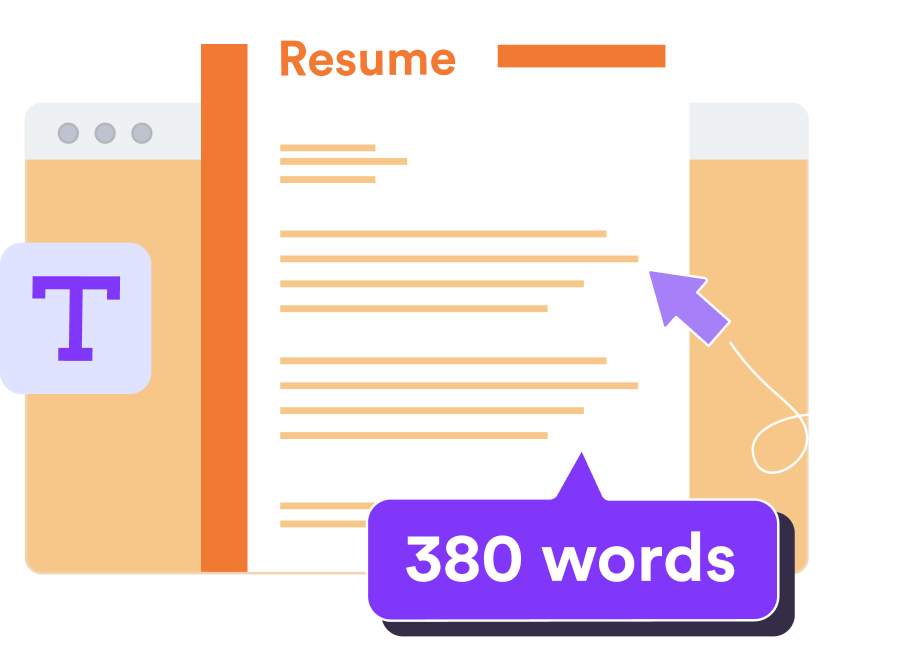Our customers have been hired by*:*Foot Note

Resume Statistics
One of the most unique ways to better understand how to write a resume is by using resume statistics. Resume statistics can give you a better idea of how other people are looking for a new job and what career advice you should be incorporating into your resume as well. If you’re looking for quantifiable results in your job hunting endeavor, you need to draw on job search statistics. Here’s how you can improve your resume templates by listening to resume statistics.
Build my resumeBasic Resume Statistics
Resume statistics start with the actual way you construct your resume. Here are a few points to consider when you’re preparing to write a resume:
- The average resume word count is around 490 when including two-page resumes, or 380 at the single-page cutoff.
- Around 25% of hiring managers only spend 30 seconds or less reviewing a resume.
- Job seekers consider these to be the top factors when looking for a new job:
- Career growth
- Health benefits
- Compensation
- Only about half of job seekers include a cover letter.
What do these statistics say about writing a resume for a job posting? First of all, shorter is better. You can’t fit a lot of information in a single resume page with only 380 words. Plus, when as many as 25% of hiring managers look at your resume for less than half a minute, you need to get across that information as quickly as possible if you’re hoping for a job offer.
Soft Skills Recruiters Love To See on a Resume
Soft skills are an important starting point when listing your key skills. These skills revolve around the way you communicate with other people and the way you handle yourself. They’re personality-based skills. Here are a few of the soft skills that might make you more likely to land a job interview:
- Communication skills
- Problem-solving skills
- Time management
- Teamwork
- Creativity
- Interpersonal skills
- Work ethic
- Adaptability
- Attention to detail
- Leadership skills
You’ll often see these skills listed in the job description of an open position.
Build my resumeHard Skills Recruiters Love To See on a Resume
What about hard skills? While soft skills are all about your personality, hard skills are specific knowledge that applies to the job you’re applying for. Here are a few of the most common hard skills you might see on a resume:
- Data analysis
- Social media
- Microsoft Office (Word, Excel, Outlook, PowerPoint)
- Project management
- Team management
- Digital marketing
- Troubleshooting
- Resource management
- Web analytics
- Operating systems
It’s important to remember that hard skills will naturally vary depending on the job. If you’re applying to be a professional resume writer, you’re probably going to need to know how to use Microsoft Office. If you’re applying to be a data scientist, you’ll need to know how to use machine learning algorithms and write in Python and SQL. Your industry will have an impact on the hard skills you use, so don’t feel like you need to use all of these skills.
Most Popular Resume Sections
When you’re constructing your resume, you need a way that you can show off everything in the very short amount of time you have. That’s where headings come into play. These are the most common resume sections on a resume:
- Contact information
- Resume summary or objective
- Skills
- Work experience
- Education
These five resume sections are the sections you need to include in your resume. However, even with this knowledge, you will likely still have a difficult time filling out your job application on your own, especially if you’re a first-time job seeker. That’s why you should use ResumeHelp to create your job application from top to bottom. You can use the ResumeHelp resume builder and the cover letter builder to write a better resume. Plus, you can also find resume examples if you want to look at other job seekers’ resumes before you write your own.
Build my resumeFAQ: Resume Statistics
Have questions? We’re here to help.
What are the most common mistakes on a resume?
There are typically four common mistakes that may make a hiring manager reject your resume outright, often without looking at any of the actual content. Avoid these mistakes if you want to get a job offer:
- Poor grammar, typos, and misspelled words
- An unprofessional email address
- Lack of quantifiable information
- Poor resume formatting
You can fix many of these problems with the resume builder at ResumeHelp. If you’re willing to use extra tools, you can avoid most of the common resume mistakes.
What percentage of resumes are rejected?
More than 70% of resumes are rejected, and a common reason for this rejection is that the resumes don’t make it past the applicant tracking system (ATS). ATS is an automated process to make it easier for a hiring manager to fill a position. With ATS, if a resume doesn’t have the right number of resume keywords, it never even makes it to the hiring manager. You can avoid this problem by actively looking for more keywords and .
Does a cover letter make your resume stand out more?
Yes. Around 45% of people applying to a job opening don’t even include a cover letter with their resume, which means that you can stand out from almost half of the applicants on average if you write a cover letter. This is just one more reason why cover letters are so important even today.
Couldn't find the answer you're looking for?






